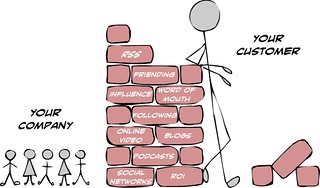In my last post, I highlighted 5 warning signs that your website sucks along with some tips to make it, um… unsuck. This time, let’s take a deeper look at how you can do the “unsuck” part even more effectively.

First off, let’s define terms. Many business people think an e-Commerce website is limited only to those sites that actively sell products or generate leads. The thinking goes, if you don’t have a shopping cart, booking engine, or lead gen form, you’re not e-Commerce.
Nonsense.
If you charge your customers for the products and services you offer and you have a website that describes, promotes, or sells those products and services, you’re in the e-Commerce business. Full stop.
What really matters is making sure that your website serves as your most effective salesperson, helping your customers — both active and potential — choose your products and services instead of the competition’s.
How do you do that?
By following these 5 straightforward laws of e-Commerce.
What are these laws? Easy:
- Solve Your Customers’ Problems First.
- Focus on Key Metrics.
- Improve Your Images.
- Highlight Your Contact Information.
- Deliver Clear, Simple Calls-to-Action.
Now let’s look at each in more detail.
Law #1: Solve Your Customers’ Problems First
I’ve mentioned many times that your customers don’t really care about you. They’ve got busy lives, with lots to do. If you make it hard for them to accomplish what they want to do, they’ll never help you accomplish what you want. It’s easy to think sometimes that your site exists for various business stakeholders or solely to attract search engines.
It doesn’t.
Not that those aren’t important. But the real goal is to help your customers achieve their goals, answer their questions, make a decision. Do that well and reaching your goals gets much, much simpler.
Law #2: Focus on Key Metrics
Some great business thinker once said you can’t manage what you can’t measure. Never was that more true than with your website. Which sources drive the most traffic to your site? Which pages get the bulk of that traffic? Where do customers get frustrated and exit? If you can’t answer these simple questions, you’ll rarely get the value from your website that you should.
Invest a little bit of money into selecting the right analytics tool for your business, then a little bit more helping your team learn to use it. You’re far better off using a free tool that your team understands than spending a fortune on something that produces reports that no one looks at.
Once you’ve got the tool and a well-trained team, use that data to drive actions designed to improve your site’s business results. Remember, we’re not not talking about “web metrics” here. We’re talking about business metrics.
Law #3: Improve Your Images
I don’t care what you sell. Anything that can be sold sells better with crisp, clear, attractive images. Even service providers can show pictures of your team at work or testimonials with pictures of satisfied clients to help future customers “see” what they’re buying.
As an added benefit, “alt” text accompanying those images (a web development technique) aids both search engines and visually-impaired customers understand what you’re showing more effectively. And there’s nothing better than doing well by doing good.
Law #4: Highlight Your Contact Information
Also known as the “We Don’t Care Where You Buy” rule. Some customers want to buy online (assuming you sell directly online). Some want to call. Some want to email you. And some want to walk into your store. While there are excellent business reasons for burying some of these (maybe you can’t offer phone support 24/7), make every channel you plan to support extremely easy to find. And, given the prevalence of local search on mobile devices, make sure that your phone number and physical address feature prominently on your mobile site.
True story: I was recently looking for an IT development shop for a client of mine. One vendor we’d considered offered only a contact form on their site, one that required me to complete the following fields to receive more information:
- First name
- Last name
- Company name
- Company address
- Job title
- Phone number
- Email address
- A description of the project
Did the company display a phone number on their site? They did not. Did they provide an email address for simple inquiries? They did not.
Did they receive a solicitation from me?
Say it with me now: They did not.
Law #5: Deliver Clear, Simple Calls-to-Action
Finally, how many times have you looked up information on a site and thought, “Great. Now what do I do?” Your pages should serve as express lanes to purchase, not cul-de-sacs. Make it easy for your customers to know what to do next, how they can get in touch with you (see Law #4), or what they need to do to buy.
Additionally, try A/B testing different copy, images, and buttons to see what your customers respond to most often.
You’d be amazed at how much just increasing the size of the text on your call-to-action buttons or changing its color can influence customer response. And improve your sales. Again, make it easy for your customers to understand what they should do next, then watch as they do just that.
Conclusion
Right now, you’re probably thinking that there’s got to be more to this. And, truthfully, there is. Depending on your business, there could be a lot more. But, it’s equally true that these 5 laws of e-Commerce play a huge role in helping your customers decide whether and from whom to buy. Getting these right is no guarantee that you’ll close every sale. But getting them wrong virtually ensures that you won’t close most. This list isn’t just a good idea. It’s the law.
Do you want to learn more about how to improve sales, increase conversions, and reduce the costs from your search marketing? Then take a moment to check out our Biznology Jumpstart Workshop: On-site Search Marketing Training. Taught by three Biznology search marketing experts, you’ll learn how to make your search marketing work for your business. Interested in learning more? Check it out today.






